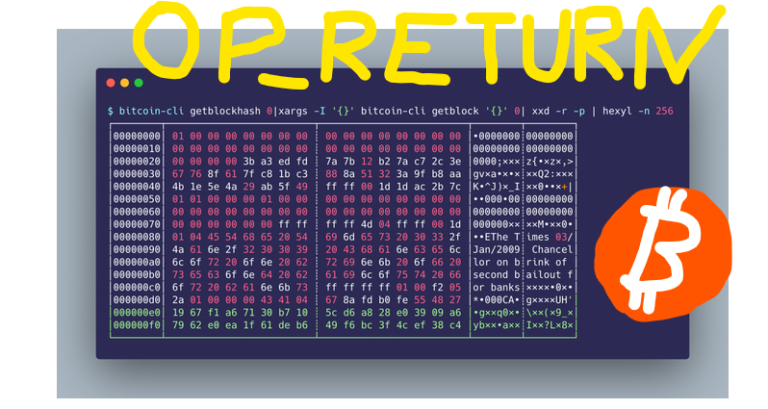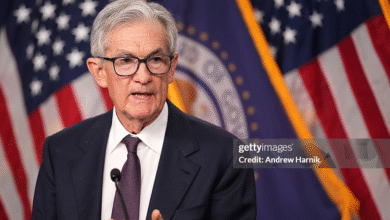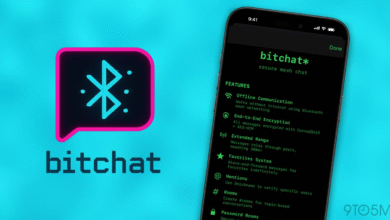Bitcoin OP_RETURN Breaks Records as Blockchain Message Board

Bitcoin OP_RETURN has emerged as a powerful tool in the cryptocurrency ecosystem, allowing users to embed data directly into the Bitcoin blockchain. With the recent transaction in block 896696, this seemingly simple feature has garnered significant attention, as it showcased an entire block filled with OP_RETURN data. This innovative application raises questions about the future of Bitcoin messaging, as enthusiasts push the boundaries of OP_RETURN transactions for creative expression. By removing traditional constraints, users seek new avenues for documentation and communication within the Bitcoin network, potentially paving the way for a more intricate interplay between digital art and P2P payment systems. As debates continue around Bitcoin node implementation and its capacity to handle such unique uses, the intrinsic value of OP_RETURN remains a focal point in discussions about the cryptocurrency’s evolution.
The concept of embedding unspendable data within the Bitcoin blockchain is revolutionizing the way users interact with the network. Known within the community as data outputs, these OP_RETURN functions allow creative messaging and innovative uses of blockchain space, sometimes marked by unique expressions or timestamping events. As alternative phrases like ‘data inscription’ or ‘blockchain messaging’ gain traction, the implications for user engagement, such as the recent 1 MB block achievement, highlight the potential for more expressive forms of communication and record-keeping. This evolution represents a shift from Bitcoin being merely a digital currency to becoming an open platform for broader creative expressions. The ongoing discussions around Bitcoin Core and node modifications reflect a community eager to explore new frontiers in blockchain technology.
Understanding Bitcoin OP_RETURN Transactions
Bitcoin’s OP_RETURN transactions offer a fascinating insight into how data can be creatively embedded within the blockchain. By design, this opcode allows users to include up to 80 bytes of arbitrary data that is not added to the Unspent Transaction Output (UTXO) set, thus minimizing blockchain bloat. The allowance for non-standard data entries provides developers with a unique opportunity to engage in innovative practices beyond mere financial transactions, tapping into the realm of artistic expression and personal messaging.
Recent events, particularly the unusual OP_RETURN transactions recorded in block 896,696, exemplify this creativity. In particular, the record-setting message that filled the entirety of the block underscores the emerging trend where Bitcoin is becoming not just a currency, but a canvas for communication. As a result, the capacity and limitations of OP_RETURN transactions have sparked discussions among developers and users alike, highlighting the balance between utility and potential misuse.
The Rise of Bitcoin Block 896696
Block 896,696 stands as a hallmark moment in Bitcoin’s history, showcasing a sizeable OP_RETURN that fills nearly 1MB of blockchain space. This unprecedented transaction drew attention not only for its size but also for the engagement it generated within the crypto community. Created by the group known as The Wizards of Ord, its purpose transcends mere monetary exchange, instead serving as a statement of artistic endeavor, signaling that Bitcoin can function as a social medium as well as a currency platform.
The method utilized to achieve this record involved bypassing traditional restrictions of Bitcoin Node Implementation. Miners, particularly those associated with Marathon, were willing to accept and include this non-standard transaction in the blockchain, marking a pivotal moment of flexibility within Bitcoin’s operational framework. This development has prompted a broader conversation about what the future of Bitcoin could hold, including potential shifts in how we understand the purpose and utility of the blockchain.
Exploring Bitcoin Messaging Through OP_RETURN
As Bitcoin evolves, the OP_RETURN opcode is opening new avenues for messaging and expression. The transformation from a straightforward financial transaction mechanism to a versatile messaging protocol illustrates a significant paradigm shift within the blockchain ecosystem. Users are now utilizing OP_RETURN not only for simple data storage but also for creative expressions, political statements, and even memes. This evolution embodies the community’s response to the digital age, where communication transcends traditional channels.
The messages embedded in OP_RETURN transactions often spark discussions and debates, proving that Bitcoin is more than just a currency. This new paradigm encourages users to articulate collective sentiments or ideas, creating a vibrant tapestry of onchain conversations. As users continue to experiment with Bitcoin messaging, the focus on OP_RETURN showcases the blockchain’s dual capacity as both a financial network and a medium for creative expression.
Implications of Removing OP_RETURN Size Constraints
The ongoing debate regarding the removal of the 80-byte limitation on OP_RETURN transactions stirs the imaginations of many within the Bitcoin community. Advocates for lifting the cap argue that it would pave the way for a more diverse range of use cases, particularly in the realm of digital art and content creation. Without stringent size restrictions, users could embed richer multimedia narratives or extensive data sets, making Bitcoin a more flexible platform for expression and innovation.
However, this potential reformation also comes with risks, including concerns over blockchain bloat and spam transactions. As more data gets added to the blockchain, issues regarding scalability and efficiency become paramount. The Bitcoin ecosystem is at a crossroads where it must weigh the benefits of creative freedom against the practicalities of network performance and sustainability.
Bitcoin and Creative Expression Through Technology
The intersection of technology and creativity within the Bitcoin network has never been more prominent. Creative expression in the context of blockchain technology, especially through mechanisms like OP_RETURN, challenges conventional perceptions of digital art and ownership. By embedding messages or artworks directly into transactions, creators can leave indelible marks within the blockchain, providing a new layer of authenticity and permanence to their work.
This blend of creativity and technology extends beyond mere artistic endeavors. It reflects the evolving nature of the Bitcoin community and its growing desire to redefine what it means to participate in this space. As users adopt OP_RETURN for diverse purposes, the importance of innovation in the Bitcoin protocol shines vividly, driving ever-evolving conversations about the blockchain’s future.
Challenges and Opportunities with Bitcoin Node Implementation
The Bitcoin Node Implementation plays a crucial role in how transactions are processed and accepted within the network. There is ongoing discourse about the flexibility of node configurations, particularly regarding parameters like -datacarrier and -datacarriersize. These options allow operators to exert control over what types of data can be relayed or stored, directly impacting the occurrence of OP_RETURN transactions in their mempool.
The growing adoption of implementations like Bitcoin Knots marks a significant shift in how nodes can manage and respond to onchain data messages. As more operators prefer to filter or restrict OP_RETURN messages, the challenge lies in finding a balance between maintaining freedom of expression within the blockchain while ensuring manageable growth and sustainability. This dynamic illustrates an ongoing evolution in real-time governance that could set important precedents for Bitcoin’s operational future.
The Future of Bitcoin Messaging and Data Transactions
As we look towards the future, the integration of messaging within Bitcoin traffic — particularly through OP_RETURN — is likely to evolve. Emerging trends suggest that Bitcoin may become an increasingly vital part of how individuals and organizations communicate, moving beyond traditional transactional uses. This integration represents an exciting frontier where practical applications of blockchain technology could align more closely with social and communicative needs.
Conversations surrounding Bitcoin messaging will only grow as communities explore its boundaries. The potential for decentralized communication platforms built on Bitcoin technology opens myriad opportunities, but such explorations will also raise questions about privacy, censorship, and the responsibility of developers and node operators in shaping this new landscape. Ultimately, Bitcoin’s adaptability could result in a robust ecosystem where financial and social interactions coexist harmoniously.
Creative Approaches to OP_RETURN Utilization
Utilizing OP_RETURN creatively offers fresh perspectives on the capabilities of Bitcoin. Beyond a tool for simple transactions, it has emerged as a medium for artistic, social, and political expression, encouraging users to deploy their imaginations within the confines of the blockchain. The unique ability to leave a permanent trace in the form of data allows innovators to engage in an evolving dialogue around the implications of their digital footprints.
The creativity displayed through OP_RETURN usage highlights a broader cultural shift within the Bitcoin community. Emphasizing narratives surrounding identity, belonging, and innovation, this movement invites artists, collectors, and enthusiasts to explore how we construct meaning and value by leveraging the capabilities of blockchain technology. This expanding cultural significance showcases the transformative potential of OP_RETURN beyond mere transaction records.
Navigating the Complex Landscape of OP_RETURN Transactions
Navigating OP_RETURN transactions in Bitcoin requires an understanding of both technical constraints and community-centric values. As mentioned previously, the discussions surrounding the 80-byte limitation shine a light on how policy decisions can affect user creativity and expression. The complexities of these transactions also necessitate a keen grasp of various node implementations and how they interact with the broader Bitcoin ecosystem.
As the debate continues surrounding OP_RETURN and its future, users, developers, and miners must work in tandem to create a balanced approach that preserves the integrity of the blockchain while allowing for creative freedom. Ultimately, the outcome will shape Bitcoin’s role as a platform for not just financial transactions, but also as a rich environment for experimentation, collaboration, and community-driven ideation.
Frequently Asked Questions
What are OP_RETURN transactions in Bitcoin?
OP_RETURN transactions are a type of Bitcoin transaction that allows users to embed non-spendable data of up to 80 bytes within the blockchain. They are often used for purposes such as timestamping, asset issuance, and creative expression on the Bitcoin network.
How did Bitcoin block 896696 feature an unusually large OP_RETURN?
Bitcoin block 896696 became notable for containing the largest OP_RETURN transaction in Bitcoin history, which almost occupied an entire megabyte of space. This was made possible by circumventing standard node policies to submit a non-standard transaction to a mining pool, showcasing the flexibility of OP_RETURN for creative data storage.
What is the significance of Bitcoin messaging through OP_RETURN?
Bitcoin messaging through OP_RETURN allows users to creatively express thoughts, art, or statements directly on the blockchain. This practice has gained traction as users harness the 80-byte data limit to deliver unique messages, such as cultural memes or personal notes, without affecting the Bitcoin network’s transaction efficiency.
Why is there a debate about lifting the 80-byte limit on OP_RETURN transactions?
The debate about lifting the 80-byte limit on OP_RETURN transactions centers on the potential for enhancing creative use of Bitcoin without significant risks of network spam. While removing the limit could promote artistic expression and expand functionality, concerns exist about overwhelming the blockchain and increasing data clutter.
How does the Bitcoin node implementation affect OP_RETURN transactions?
Different Bitcoin node implementations, such as Bitcoin Knots, enable varying levels of control over OP_RETURN transactions. For instance, Knots allows operators to set specific flags to reject or restrict OP_RETURN data sizes, influencing which transactions are accepted or relayed on the network.
What role does creative expression play in Bitcoin OP_RETURN transactions?
Creative expression in Bitcoin OP_RETURN transactions manifests as users embed various forms of messages and art within the blockchain. These transactions not only reflect personal creativity but also highlight the evolving use of Bitcoin, transforming the blockchain into a medium for cultural commentary and digital expression.
Can OP_RETURN transactions impact Bitcoin’s scalability?
Yes, OP_RETURN transactions can impact Bitcoin’s scalability by influencing block space usage and transaction fees. While they don’t contribute to the UTXO set, excessive use could lead to larger blocks or necessitate stricter policies to manage data volume, thus affecting overall network performance.
What are the implications of the OP_RETURN War of 2025?
The OP_RETURN War of 2025 reflects ongoing discussions within the Bitcoin community about the future of data storage on the blockchain. It emphasizes the balance between creative usage and the network’s efficiency, as well as the community’s values regarding data integrity and policy enforcement.
How does op_return relate to Bitcoin’s peer-to-peer payment system?
OP_RETURN can be seen as a departure from Bitcoin’s primary function as a peer-to-peer payment system, instead allowing for data storage and creative messaging. This dual-use case sparks discussions about Bitcoin’s purpose, potentially redefining its role in the blockchain ecosystem.
| Key Point | Description |
|---|---|
| Introduction of OP_RETURN | Bitcoin’s OP_RETURN opcode allows embedding unspendable data up to 80 bytes. |
| Current Debate | The debate centers around removing the 80-byte limit, sparking what is referred to as the OP_RETURN War of 2025. |
| Record Block Creation | Block 896,696 had a non-standard OP_RETURN transaction that filled an entire block with nearly 1 MB of data. |
| Creative Uses of OP_RETURN | OP_RETURN is being used for creative expression, including messages and timestamps. |
| Node Software Changes | The adoption of Bitcoin Knots offers more control over OP_RETURN transactions than Bitcoin Core. |
| Miner Incentives | Miners may include data-heavy OP_RETURN transactions if the fees are deemed sufficient. |
Summary
Bitcoin OP_RETURN has recently emerged as a focal point in the evolving landscape of blockchain technology, demonstrating how the protocol can serve as a canvas for creative expression while sparking significant debate over its limitations. The ongoing discussions surrounding OP_RETURN are indicative of a broader desire within the Bitcoin community to explore its capabilities beyond mere financial transactions, potentially reshaping its future in the digital realm.




